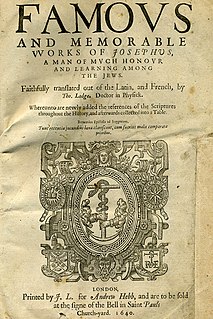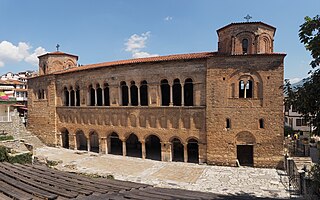 W
WThe Golden Age of Bulgaria is the period of the Bulgarian cultural prosperity during the reign of emperor Simeon I the Great (889—927). The term was coined by Spiridon Palauzov in the mid 19th century. During this period there was an increase of literature, writing, arts, architecture and liturgical reforms.
 W
WThe Christianization of Bulgaria was the process by which 9th-century medieval Bulgaria converted to Christianity. It reflected the need of unity within the religiously divided Bulgarian state as well as the need for equal acceptance on the international stage in Christian Europe. This process was characterized by the shifting political alliances of Boris I of Bulgaria with the kingdom of the East Franks and with the Byzantine Empire, as well as his diplomatic correspondence with the Pope.
 W
WThe Church of Saints Clement and Panteleimon is a Byzantine church situated on Plaošnik in Ohrid, North Macedonia. It is attributed to Saint Clement of Ohrid, a disciple of Saint Cyril and Saint Methodius. Archaeologists have come to believe that the church is located on the site where the first students of the Glagolitic alphabet were taught into the First Bulgarian Empire.
 W
WDidactic gospels is a collection of sermons. Their prototype is considered the didactic of Bishop Constantine of Preslav in 894 written in the Church Slavonic language.
 W
WThe Early Cyrillic alphabet, also called classical Cyrillic or paleo-Cyrillic, is a writing system that was developed in the First Bulgarian Empire during the late 9th century on the basis of the Greek alphabet for the Slavic peoples living near the Byzantine Empire in South East and Central Europe. It was used by Slavic peoples in South East, Central and Eastern Europe.
 W
WThe Monastery of Saint Naum is an Eastern Orthodox monastery in North Macedonia, named after the medieval Saint Naum who founded it. It is situated along Lake Ohrid, 29 kilometres (18 mi) south of the city of Ohrid.
 W
WPlaošnik or simply Plaoš is an archaeological site and holy place in Ohrid, 250 meters below Samuil's Fortress. In the future, the whole complex will have konaks (mansions) as in the time of Saint Clement of Ohrid, together with several surrounding objects.
 W
WRavna Monastery was a literary center of the Preslav Literary School during the 9th and 10th centuries in the north-eastern part of the Bulgarian Empire. It is located near the village of Ravna, at 11 km northwest of the town of Provadia, Varna Province, north-eastern Bulgaria. It was studied in the 1980s.
 W
WThe Round Church, also known as the Golden Church or the Church of St John, is a large partially preserved early medieval Eastern Orthodox church. It lies in Preslav, the former capital of the First Bulgarian Empire, today a town in northeastern Bulgaria. The church dates to the early 10th century, the time of Tsar Simeon I's rule, and was unearthed and first archaeologically examined in 1927–1928.
 W
WIvan Alexander, also sometimes Anglicized as John Alexander, ruled as Emperor (Tsar) of Bulgaria from 1331 to 1371, during the Second Bulgarian Empire. The date of his birth is unknown. He died on 17 February 1371. The long reign of Ivan Alexander is considered a transitional period in Bulgarian medieval history. Ivan Alexander began his rule by dealing with internal problems and external threats from Bulgaria's neighbours, the Byzantine Empire and Serbia, as well as leading his empire into a period of economic recovery and cultural and religious renaissance.
 W
WThe Slavonic Josephus is an Old East Slavic translation of Flavius Josephus' History of the Jewish War which contains numerous interpolations and omissions that set it apart from all other known versions of Josephus' History. The authenticity of the interpolations was a major subject of controversy in the 20th century, but the latest scholarship has rejected them.
 W
WThe Church of Saint Sophia is a church in Ohrid, North Macedonia. The church is one of the most important monuments of North Macedonia, housing architecture and art from the Middle Ages.
 W
WIn Slavic Christianity, the trilingual heresy or Pilatian heresy is the idea that Biblical Hebrew, Greek, and Latin are the only valid liturgical languages or languages in which one may praise God. Trilingualism was rejected in the 850s by Saints Cyril and Methodius, Byzantine brothers and missionaries who introduced a Christian liturgy in the vernacular of their Slavic converts, a language now called Old Church Slavonic.